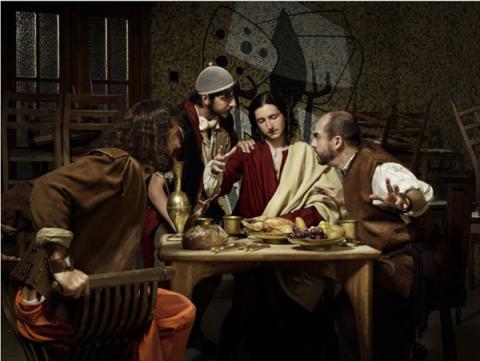Erwin Olaf
Supper at Emmaus (2008, photography)

Emmaus was a village in Judea, about ten kilometers from Jerusalem, where, according to the gospel of the prophet Luke, Christ appeared to two disciples after his death. The disciples were on their way home and did not initially recognize Jesus, even though he spoke pedantically about good and evil. The photograph by Erwin Olaf shows the supper at Emmaus, at the moment when it becomes clear in the inn—using the same gestures as during the Last Supper—that the stranger is Christ. The breaking and blessing of the bread would develop into a central act in Catholic liturgy.
The staged photograph by Erwin Olaf (1959) is a contemporary adaptation of a painting by the Italian painter Caravaggio from 1602. The bewilderment of the two disciples—exactly as in Caravaggio's case—is primarily expressed in their gestures. One spreads his arms in surprise, the other jumps up from his chair.
As with Caravaggio, this scene is characterized by a light that heightens the drama of the moment. What was further striking about Caravaggio was that Christ was depicted without a beard, which was completely unusual. Equally unusual is the fact that Olaf almost imperceptibly introduces contemporary elements into the image: a wristband on the man on the right, a watch on the man on the left, and the hem of his underpants.
The work is in the university's art collection because it is an actualization of a Biblical theme, with resources from modern times. Like Caravaggio, Olaf takes the liberty of shaping the scene to his liking, while respecting the larger story. Olaf's work is included in various collections, including those of the Groninger Museum, the Stedelijk Museum and Rijksmuseum in Amsterdam, Gemeentemuseum Den Haag and various private collections, such as that of Elton John.
More about history and academic heritage
The Tilburg University academic heritage is a very diverse set of archives, visual materials, collections, devices, recorded stories, et cetera that relate to the history of the university.